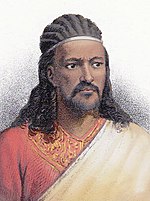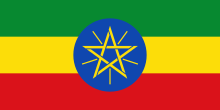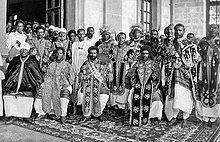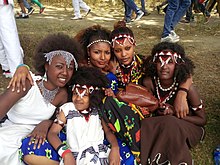A | B | C | D | E | F | G | H | CH | I | J | K | L | M | N | O | P | Q | R | S | T | U | V | W | X | Y | Z | 0 | 1 | 2 | 3 | 4 | 5 | 6 | 7 | 8 | 9
| Total population | |
|---|---|
 | |
| Regions with significant populations | |
| 750,000 (Ethiopian-born)[1] | |
| 460,000[2] | |
| 200,000[3] | |
| 155,300[4] | |
| 90,000[5] | |
| 73,000 refugees[6] | |
| 44,891 (Ethiopian-born)[7] | |
| 44,065[8] | |
| 42,244[9] | |
| 36,889 (Ethiopian-born)[7] | |
| 30,000[2] | |
| 20,465[10] | |
| 19,349[11][12] | |
| 12,786 (Ethiopian-born)[7] | |
| 12,380[13] | |
| 12,323 (Ethiopian-born)[7] | |
| 9,451 (Ethiopian-born)[7] | |
| 8,675 (Ethiopian-born)[7] | |
| 6,424 (Ethiopian born)[14] | |
| 5,740 (Ethiopian-born)[7] | |
| 5,211 (Ethiopian-born)[7] | |
| 3,713 (Ethiopian-born)[7] | |
| 3,595 (Ethiopian-born)[7] | |
| 2,420 (Ethiopian-born)[7] | |
| 2,366 (Ethiopian-born)[7] | |
| 2,136 (Ethiopian-born)[7] | |
| 2,079 (Ethiopian-born)[7] | |
| 1,831 (Ethiopian-born)[7] | |
| 1,667 (Ethiopian-born)[7] | |
| 1,457 (Ethiopian-born)[7] | |
| 1,276 (Ethiopian-born)[7] | |
| 1,187 (Ethiopian-born)[7] | |
| 1,143 (Ethiopian-born)[7] | |
| 1,070 (Ethiopian-born)[7] | |
| Languages | |
| Amharic, Oromo, Somali, Tigrinya, Wolaytta, Gurage, Sidamo and other Languages of Ethiopia | |
| Religion | |
| Christian 60.9% - Predominantly Oriental Orthodox (Ethiopian Orthodox Tewahedo Church), Muslim 35.6%, Traditional 2.6%. Jewish 1%[15] | |
| Related ethnic groups | |
| Eritreans, Djiboutians, Somalis, other Horn Africans, and other Afro-Asiatic and Nilo-Saharan populations. | |
Ethiopians are the native inhabitants of Ethiopia, as well as the global diaspora of Ethiopia. Ethiopians constitute several component ethnic groups, many of which are closely related to ethnic groups in neighboring Eritrea and other parts of the Horn of Africa.
The first documented use of the name "Ethiopia" from Greek name "Αἰθίοψ" (Ethiopian) was in the 4th century during the reign of Aksumite king Ezana. There were three ethnolinguistic groups in the Kingdom of Aksum; Semitic, Cushitic, and Nilo-Saharan (ancestors of the modern-day Kunama and Nara). The Kingdom of Aksum remained a geopolitically influential entity until the pillage of its capital — also named Axum — in the 10th century by Queen Gudit. Nevertheless, the core Aksumite civilization was preserved and continued into the successive Zagwe dynasty. By this time, new ethnic groups emerged – the Tigrayans and Amharas. During the Solomonic period, the latter established major political and cultural influence in the Horn of Africa. In the Late Middle Ages, Muslim states were established, including the Sultanate of Ifat, and its successor the Adal Sultanate. Discontent with territory and religious dominance led to intense war between the Ethiopian Empire, the Christian state, (consisting of the Amhara, Tigrayan, Soddo Gurage, and Agaw ethnic groups) and the Muslim state Adal Sultanate (consisting of Semitic speaking Harari formally known as the Harla people, and the Argobba). During the 1600s, there were large-scale migrations of the Oromo from the south into the highlands and also alongside the Somali into Adal or what was known as "Hararghe" (land of the Hararis).
A period of stability and peace continued through the Gondarine period in 16th and 17th century, but Ethiopia was divided into de facto autonomous regions in the mid-18th century. During this time, Ethiopia was nominally ruled by an Emperor who functioned as a puppet monarch of various regional lords and noblemen. This era was known as the Zemene Mesafint or "Era of the Princes". Emperor Tewodros II managed to unify the decentralized Ethiopian Empire in 1855 and inaugurated a process of modernization that continued into successive regimes, resurrecting the empire as a regional power.
In the late 19th-century during the reign of Menelik II, against the backdrop of the Scramble for Africa, the notion of Ethiopian national integrity was strengthened by Italian efforts at colonization. The Italian invasion engendered a formidable national resistance, culminating in the Battle of Adwa in 1896 which resulted in a major Ethiopian victory against the Italians. The resulting Treaty of Addis Ababa ended the Italo-Ethiopian War, and along with the nation's contemporaneous territorial expansion, largely established the modern-day boundaries of Ethiopia.
Present-day Ethiopia has a diverse population with many different languages and ethnic groups. Ethiopians speak Afro-Asiatic languages (Semitic, Cushitic, and Omotic) and Nilo-Saharan languages. The Oromo, Amhara, Somali and Tigrayans make up more than three-quarters (75%) of the population, but there are more than 80 different ethnic groups within Ethiopia. Some of these have as few as 10,000 members.
History
Prehistory
Archaeologist found remains of early hominins, one of the most specimen was Australopithecus afarensis, also called "Lucy", which was discovered in the country's Awash Valley, so-called Hadar in 1974. It is estimated to be 3.5 million years old. In October 2015, scientists found a 4,500 years ago lived man called Mota in a cave in southern central Ethiopia. Atypical to Euroasians, which were believed reached the region after him, Mota's genetic variants was not as "light-colored eye or skin", resembles the modern Aari tribes that live in the southern area of the country. Another research suggests that Euroasians arrived in the region resembles modern-day Sardinians, or likely LBK culture of antiquity.[16] By proofing Mota has no European genome, archeologist theorized the Near East population migrated to Africa in 3,000 years ago.[17] Other evidence concluded that Eurasian population made significant contribution as a result of back migration between 1,500 and 3,500 years ago. Nilo-Saharan peoples do not exhibit this genetic similarity; instead, their DNA shows evidence of more recent admixture (less than 1200 years ago) with other African peoples.[18] It was thought that Hamitic people from Asia Minor had migrated before Semitic Arabian people in the 7th century BC.[19] In 1933, G.W.B Huntingford proposed a theory of Azanian civilization could existed in Kenya, and northern Tanzania, between the Stone Age and Islamic period. It was supposed that these people evicted from Ethiopia and Somalia by Muslim invasion to southern region in present-day Kenya and Tanzania where perished around 14th- and 15th-century.[20]
About 7000 BC, Afro-Asiatic-speaking population namely Cushitic and Omotic-speaking people grouped in the present day of Ethiopia after which diversification thrived in the area and allowed the other local groups, the Agaws, Somali, Oromo, and numerous Omotic-speaking groups to unify. Originally a hunter gatherers, those people began domesticating indigenous plants thereafter, including the grasses teff, eleusine, enset, root crop, and domestication of cattles and other animals to fill agricultural livelihoods that still contemporary followed. By the late first millennium BC, the Agaws occupied the northern Ethiopian region, as the Sidamo occupied the central and southern parts of Ethiopia, making inaugural historical development of Ethiopia.[21]
Afro-Asiatic languages were present in Africa and the Middle East by the eighth to sixth millennium BCE. This language family includes various modern and extinct African and Asian languages such as Oromo, Somali, Egyptian, Berber, Hausa, Hebrew, Arabic, Aramaic, and Akkadian. Ge'ez was developed around sixth century BCE and evident by inscriptions of contemporary kingdom of D'mt.[22] The language dominance was eclipsed by 1000 AD, but the highland inhabitants used it as written scholar and liturgical language between 300s and 1800s.[23]
Antiquity
In 980 BCE, Dʿmt was established in present-day Eritrea and the Tigray Region of Ethiopia, straddling South Arabia in present-day of Yemen. This polity's capital was located at Yeha, in what is now northern Ethiopia. Most modern historians consider this civilization to be a native Ethiopian one, although in earlier times many suggested it was Sabaean-influenced because of the latter's hegemony of the Red Sea.[24]
Other scholars regard Dʿmt as the result of a union of Afroasiatic-speaking cultures of the Cushitic and Semitic branches; namely, local Agaw peoples and Sabaeans from Southern Arabia. However, Ge'ez, the ancient Semitic language of Ethiopia, is thought to have developed independently from the Sabaean language, one of the South Semitic languages. As early as 2000 BCE, other Semitic speakers were living in Ethiopia and Eritrea where Ge'ez developed.[25][26] Sabaean influence is now thought to have been minor, limited to a few localities, and disappearing after a few decades or a century. It may have been a trading or military colony in alliance with the Ethiopian civilization of Dʿmt or some other proto-Axumite state.[24] Politically integrated, the Kingdom of Aksum was emerged independently from at least 100 BC, and its civilization grew from 1st century AD. The kingdom dominated the Red Sea, the Northeast Africa in the present location between northern Ethiopia (Tigray Region), eastern Sudan, Eritrea, South Arabia. It was by far powerful empire and trading nation between Roman Empire and India. The Aksumite lingua franca was Greek evolved from Hellenistic period in 330–305 BC[citation needed] and officially adopted in the first century. It was soon replaced by Ge'ez in the 4th century. Politically and culturally influenced partially with Byzantine Empire, the Aksumite achieved major historical grounds, Orthodox Tewahedo Christianity introduced and has been state religion in the early 4th century, construction of stone-fitted palace and public buildings, and erection of large obelisks around the capital Axum. These all are milestones that culminate in the rise of Ethiopian identity where the Greek exonym "Ethiopians" came to use by the kingdom under king Ezana's reign in the 4th century.[27][21] The first century BCE Greek historian Diodorus Siculus claimed the Ethiopian nativity as "true natives", "most pious and righteous" in his record. This assertion resonated by locality of declaring themselves a "Habesha people".[28] His record expounded the nature of Ethiopians, including highly proselytizing to neighboring Egypt. He denoted these people locating in the place superimposed by Nubia and Meroë, connected to the Nile river, having distinct rainy season and wonderful lake.[29]
Middle Ages

The kingdom enlarged its territory by the half of 4th century after conquering neighbor city Meroë in 330, and entered "Golden Age" for the next three centuries. Aksum's power began declining at time of Islamic Golden Age, where they frequently countered intrusions by Arab Muslims in the South Arabia protectorate (modern Yemen), making them to evicted more in the southern of Agaw population. In 10th century, the kingdom ultimately collapsed followed by pillage by Queen Gudit, after execution of Christians and ordered arson in church. While Aksum's existence extinguished, the follow-up kingdom of Zagwe likely of a continuation of its civilization and revival of Christianity, and a new multi-ethnic empire-state was formed in title of "king of kings".
The successful integration of Agaw and Semitic groups in the north prolonged over millennium and eventually forms Tigrayans and Amhara people. The Zagwe kingdom capital, relocated to Lalibela, and sparked a new cultural life. The most notable churches in this period was constructed with unique rock-hewn architecture. A dominant group, Amhara, continues to expand its territory in so-called Solomonic period after the downfall of Zagwe in 1270, and by the late 13th century, they reached to southern Shewa. Since then, centralized military unit was buildup while frequently engaged war with Sidama kingdom in the west and Muslim population to the east.
One of the most important era for Christian and Muslim insight, and the resultant of religious war was in the mid-16th century of Ethiopian–Adal War, involving the Amhara, Tigrayan and Agaw force allied to the Ethiopian Empire (Abyssinia) and the Muslim states composed mostly of Harari and Somali people, together forms the Adal Sultanate. The Oromo people additionally took an advantage of the war and occupied much the northern highland zone of the Amhara empire in the Oromo migrations.[21]
Early modern period
The Oromo remained predominantly pastoral life who dominated the Amhara empire of Abyssinia for the rest of era. A blossom life continued throughout early modern period with the founding of capital Gondar in the early 18th century, by Emperor Fasilides, commencing a "Gondarine period".

Between 1769 and 1855, Ethiopia experienced a period of isolation referred to as the Zemene Mesafint or "Age of Princes". The Emperors became figureheads, controlled by regional lords and noblemen like Ras Mikael Sehul of Tigray, Ras Wolde Selassie of Tigray, and by the Yejju Oromo dynasty of the Wara Sheh, such as Ras Gugsa of Yejju. Prior to the Zemene Mesafint, Emperor Iyoas I had introduced the Oromo language (Afaan Oromo) at court, instead of Amharic.[31][32] In 1855, Emperor Tewodros II sought to establish permanent Ethiopian border by solidifying the Shewan kingdoms. Tewodros II is often credited with being the preliminary figure of modern Ethiopian history but his reign ended prematurely when he committed suicide during the British Expedition to Abyssinia.

Emperor Menelik II done major reformations to the country by the late 1890s: under his reign, Menelik extensively conquered the rest of kingdoms nearby region, while annexing the Tigray Province, ultimately formed the modern border of Ethiopia. His reign brought sharp solidification of the current Ethiopian national identity. The Battle of Adwa was a 1896 colonial resistance battle between the Ethiopian Empire led by Menelik and Kingdom of Italy led by General Oreste Baratieri, involving respective 100,000 and 17,700 troops,[33] where Ethiopian armies decisively defeated them and secured sovereignty.[21] The battle became signature national pride among Ethiopians, and beyond for Pan-Africanism. The Treaty of Addis Ababa (1896) settled an end of Italo-Ethiopian War, and modern border of Ethiopia was created as a background of ceased foreign external pressure against the sovereignty of Ethiopia. Ethiopia, along with Liberia, became the only independent African survivors against the European colonization.[34]
Current era

An Italian occupation of Ethiopia following Second Italo-Ethiopian War brought legacy of ethnic marginalization of major ethnic groups: the Oromos, Amharas, Tigrayans, and Somalis. Ethiopia underwent series civil clashes under communist military junta Derg. Ethnic nationalism and similar policies implemented by the Ethiopian Peoples' Revolutionary Democratic Front (EPRDF), which brought Ethiopia to ethnic federalist state since 1995, which was aimed to reduce internal ethnic conflicts and grant freedom of choice within every ethnic groups although, Ethiopia then faced more prolong internal conflicts and ethnic clashes in the 21st-century.[36]
Ethnicity




Major ethnic groups
- Oromo 30.4%
- Amhara 27.0%
- Somali 6.1%
- Tigray 6.1%
- Sidama 4.0%
- Gurage 2.5%
- Welayta 2.3%
- Hadiya 1.7%
- Afar 1.7%
- Gamo 1.5%
- Other ethnic groups 12.6%[37][38]
List
| Ethnic group |
Language family |
Census (1994) [39] |
Census (2007) [38][40] | ||
|---|---|---|---|---|---|
| Number | % | Number | % | ||
| Aari | Omotic | 155,002 | 0.29 | 289,835 | 0.39 |
| Afar | Afro-Asiatic | 979,367 | 1.84 | 1,276,374 | 1.73 |
| Agaw-Awi | Afro-Asiatic | 397,491 | 0.75 | 631,565 | 0.85 |
| Agaw-Hamyra | Afro-Asiatic | 158,231 | 0.30 | 267,851 | 0.36 |
| Alaba | Afro-Asiatic | 125,900 | 0.24 | 233,299 | 0.32 |
| Amhara | Afro-Asiatic | 16,007,933 | 30.13 | 19,878,199 | 26.95 |
| Anuak | Nilotic | 45,665 | 0.09 | 85,909 | 0.12 |
| Arbore | Afro-Asiatic | 6,559 | 0.01 | 6,840 | 0.01 |
| Argobba | Afro-Asiatic | 62,831 | 0.12 | 140,134 | 0.19 |
| Bacha | Nilo-Saharan | 2,632 | < 0.01 | ||
| Basketo | Omotic | 51,097 | 0.10 | 78,284 | 0.11 |
| Bench | Omotic | 173,123 | 0.33 | 353,526 | 0.48 |
| Berta | Nilo-Saharan | 183,259 | 0.25 | ||
| Bodi | Nilo-Saharan | 4,686 | 0.01 | 6,994 | 0.01 |
| Brayle | ???? | 5,002 | 0.01 | ||
| Burji | Afro-Asiatic | 46,565 | 0.09 | 71,871 | 0.10 |
| Bena | ???? | 27,022 | 0.04 | ||
| Beta Israel | Afro-Asiatic | 2,321 | <0.01 | ||
| Chara | Omotic | 6,984 | 0.01 | 13,210 | 0.02 |
| Daasanach | Afro-Asiatic | 32,099 | 0.06 | 48,067 | 0.07 |
| Dawro | Omotic | 331,483 | 0.62 | 543,148 | 0.74 |
| Debase/ Gawwada | Afro-Asiatic | 33,971 | 0.06 | 68,600 | 0.09 |
| Dirashe | Afro-Asiatic | 30,081 | 0.04 | ||
| Dime | Omotic | 6,197 | 0.01 | 891 | <0.01 |
| Dizi | Omotic | 21,894 | 0.04 | 36,380 | 0.05 |
| Donga | Afro-Asiatic | 35,166 | 0.05 | ||
| Fedashe | ???? | 7,323, | 0.01 | 3,448 | < 0.01 |
| Gamo | Omotic | 719,847 | 1.35 | 1,107,163 | 1.50 |
| Gebato | ???? | 75 | <0.01 | 1,502 | < 0.01 |
| Gedeo | Afro-Asiatic | 639,905 | 1.20 | 986,977 | 1.34 |
| Gedicho | ???? | 5,483 | 0.01 | ||
| Gidole | Afro-Asiatic | 54,354 | 0.10 | 41,100 | 0.06 |
| Goffa | Omotic | 241,530 | 0.45 | 363,009 | 0.49 |
| Gumuz | Nilo-Saharan | 121,487 | 0.23 | 159,418 | 0.22 |
| Gurage | Afro-Asiatic | 2,290,274 | 4.31 | 1,867,377 | 2.53 |
| Silt'e | Afro-Asiatic | 940,766 | 1.27 | ||
| Hadiya | Afro-Asiatic | 927,933 | 1.75 | 1,269,382 | 1.72 |
| Hamar | Omotic | 42,466 | 0.08 | 46,532 | 0.06 |
| Harari | Afro-Asiatic | 200,000 | 0.04 | 246,000 | 0.04 |
| Irob | Afro-Asiatic | 33,372 | 0.05 | ||
| Kafficho | Omotic | 599,188 | 1.13 | 870,213 | 1.18 |
| Kambaata | Afro-Asiatic | 499,825 | 0.94 | 630,236 | 0.85 |
| Konta | Omotic | 83,607 | 0.11 | ||
| Komo | Nilo-Saharan | 1,526 | <0.01 | 7,795 | 0.01 |
| Konso | Afro-Asiatic | 153,419 | 0.29 | 250,430 | 0.34 |
| Koore | Omotic | 107,595 | 0.20 | 156,983 | 0.21 |
| Kontoma | Afro-Asiatic | 0.4 | 48,543 | 0.05 | |
| Kunama | Nilo-Saharan | 2,007 | <0.01 | 4,860 | 0.01 |
| Karo | Omotic | 1,464 | < 0.01 | ||
| Kusumie | ???? | 7,470 | 0.01 | ||
| Kwegu | Nilo-Saharan | 4,407 | 0.01 | ||
| Male | Omotic | 46,458 | 0.09 | 98,114 | 0.13 |
| Mao | Omotic | 16,236 | 0.03 | 43,535 | 0.06 |
| Mareqo | Afro-Asiatic[41] | 38,096 | 0.07 | 64,381 | 0.09 |
| Mashola | Afro-Asiatic | 10,458 | 0.01 | ||
| Mere people | ???? | 14,298 | 0.02 | ||
| Me'en | Nilo-Saharan | 52,815 | 0.10 | 151,489 | 0.20 |
| Messengo | ???? | 15,341 | 0.03 | 10,964 | 0.01 |
| Majangir | Nilo-Saharan | 21,959 | 0.03 | ||
| Mossiye | Afro-Asiatic | 9,207 | 0.02 | 19,698 | 0.03 |
| Murle | Nilo-Saharan | 1,469 | < 0.01 | ||
| Mursi | Nilo-Saharan | 3,258 | 0.01 | 7,500 | 0.01 |

